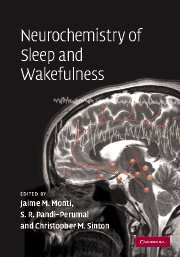Book contents
- Frontmatter
- Contents
- List of contributors
- Preface
- Acknowledgements
- Abbreviations
- I The neurochemistry of the states of sleep and wakefulness
- II The influence of neurotransmitters on sleep and wakefulness
- 4 Gamma-aminobutyric acid and the regulation of paradoxical, or rapid eye movement, sleep
- 5 Acetylcholine modulates sleep and wakefulness: a synaptic perspective
- 6 Histamine in the control of sleep–wakefulness
- 7 Dopamine in behavioral state control
- 8 Glutamate neurotransmission and sleep
- 9 Serotonin and sleep–wake regulation
- III Changing perspectives
- Index
- Plate section
6 - Histamine in the control of sleep–wakefulness
from II - The influence of neurotransmitters on sleep and wakefulness
Published online by Cambridge University Press: 23 October 2009
- Frontmatter
- Contents
- List of contributors
- Preface
- Acknowledgements
- Abbreviations
- I The neurochemistry of the states of sleep and wakefulness
- II The influence of neurotransmitters on sleep and wakefulness
- 4 Gamma-aminobutyric acid and the regulation of paradoxical, or rapid eye movement, sleep
- 5 Acetylcholine modulates sleep and wakefulness: a synaptic perspective
- 6 Histamine in the control of sleep–wakefulness
- 7 Dopamine in behavioral state control
- 8 Glutamate neurotransmission and sleep
- 9 Serotonin and sleep–wake regulation
- III Changing perspectives
- Index
- Plate section
Summary
Summary
Wakefulness is a prerequisite for survival and is accompanied by an ensemble of other behaviors. Thus, the brain contains multiple and grossly redundant systems controlling wakefulness: the histaminergic system is one of them. The histaminergic system in the central nervous system (CNS) is exclusively localized within the tuberomammillary nucleus (TMN). It consists of histamine-containing neurons that innervate almost all the major regions of the CNS, including the spinal cord. Within the CNS, histamine mediates its effects via three G-protein coupled metabotropic receptors: the H1, H2, and H3 receptors. Of these three receptors, the H3 receptor functions as an autoreceptor and regulates the synthesis and release of histamine. The histaminergic system, like other monoaminergic systems, is implicated in the regulation of sleep–wakefulness. It has been suggested that TMN neurons are under inhibitory control of the sleep-inducing ventrolateral preoptic GABAergic neurons and induce wakefulness by activating the wakefulness-promoting cholinergic neurons of the basal forebrain via the H1 receptor. Although the bulk of evidence is derived from pharmacological studies, numerous electrophysiological and biochemical studies also support the role of histamine in wakefulness.
Electrophysiological evidence suggests that the histaminergic neurons, like other monoaminergic neurons, have their highest discharge during wakefulness. Biochemical evidence also suggests that histamine release in the TMN and other target regions is highest during wakefulness.
- Type
- Chapter
- Information
- Neurochemistry of Sleep and Wakefulness , pp. 144 - 178Publisher: Cambridge University PressPrint publication year: 2008



